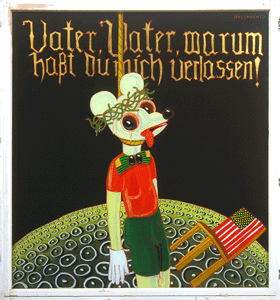Here’s the outrage—Blalla Hallman takes aim at propriety
“The Holy Family,” a group of gleefully blasphemous pictures at the Thomas Erben Gallery, is the first U.S. exhibition by German artist Blalla Hallmann in the last 40 years. Painted directly onto discarded hospital windows, the nine large reverse glass paintings depict scenes from a trippy Passion Play, starring Mickey Mouse as Jesus Christ and Daffy Duck as the “Vulva Madonna,” with a supporting cast of praying penises in Nazi regalia.
Academically trained in Düsseldorf, Hallmann (1941-1997) was institutionalized in San Francisco during the late 1960s after suffering a mental breakdown. Visual tropes borrowed from both American culture and his Catholic upbringing form the nexus for the caustic, visceral humor, and moral outrage that runs through all the work in the exhibition. American flags, dollar signs, halos, and crucifixes abound. Hallmann’s affectionate renditions of iconic Disney characters link his images to both the pre-corporate pop culture of the 1920s and ‘30s, and the infectiously screwy and scatalogical works of R. Crumb and Peter Saul from the 1960s.
Spindly gold script forms a banner across the top edge of each painting, admonishing viewers to “Revere the Holy Family!” or punning on familiar religious sayings such as “Father! Your Kingdom Coma!” In “Father, Father, why Hate You Forsaken Me!” A forlorn Mickey Mouse, dressed comically in short pants, bow tie, and crown of thorns hangs from a noose. In “Force, Smacks, Lies,” a blind mouse dressed as a cardinal and his floozy duck consort ride in a cart piled high with shit and buzzing flies. A boy mouseketeer gamely pulls his parental load while a dollar sign is dangled before his eyes, goading him on.
Rooted in folk art, reverse painting on glass is a poor man’s stained glass. The process flattens an image, pressing it up against the surface while the viewer’s reflection places her within the picture plane. Hallmann’s pictures are further simplified by the repeated use of forced perspective, bright cartoon color and black grounds, giving his work a ferocity and directness. Hallmann’s self-conscious adoption of various outsider and folk genres is particularly resonant at this moment when the “untrained” aesthetic favored by so many contemporary, academically-trained painters has come to represent a fetishized sign for authenticity.
Hallmann’s paintings make one realize how stealthy and insidious the taint of self-censorship is. Given the current state of global affairs, one might rightfully expect more visual bile and outrage to emanate from America’s art studios. Yet the art world’s cozy relationship with the political left looks polite, self-serving, and parochial next to Hallmann’s rude declarations.
gaycitynews.com



































